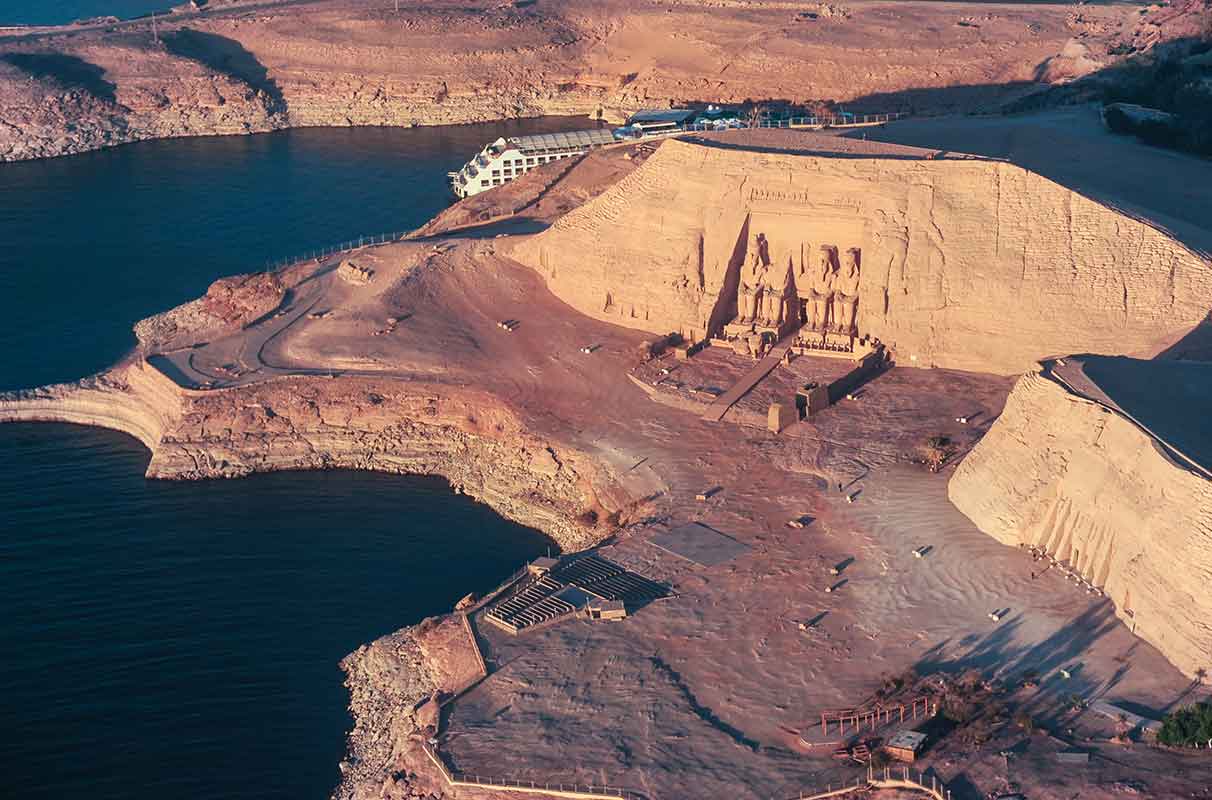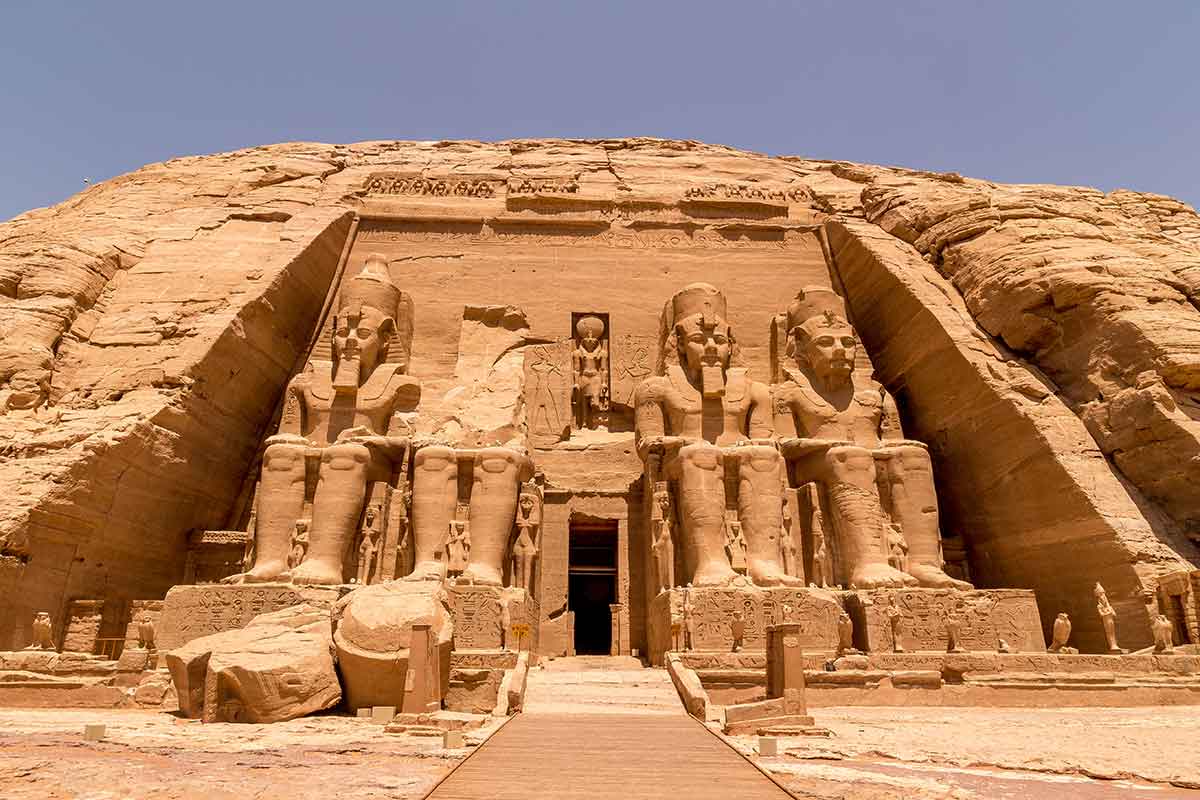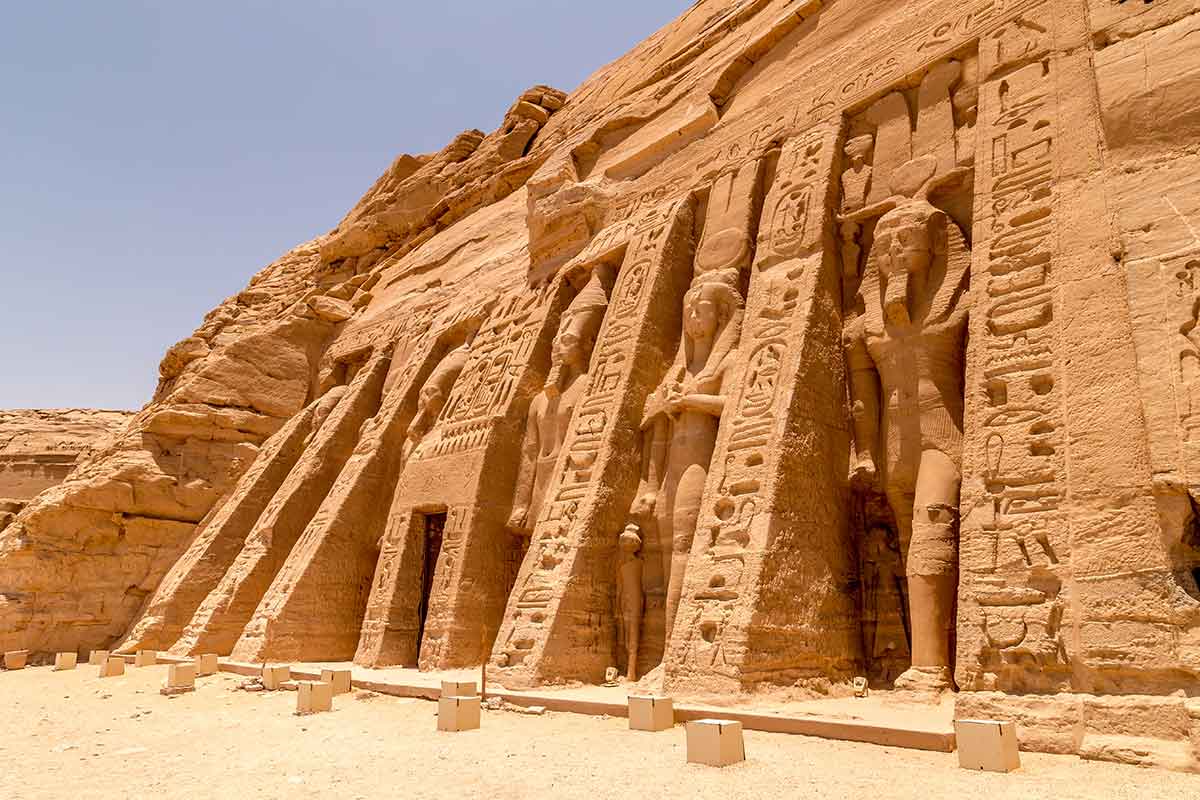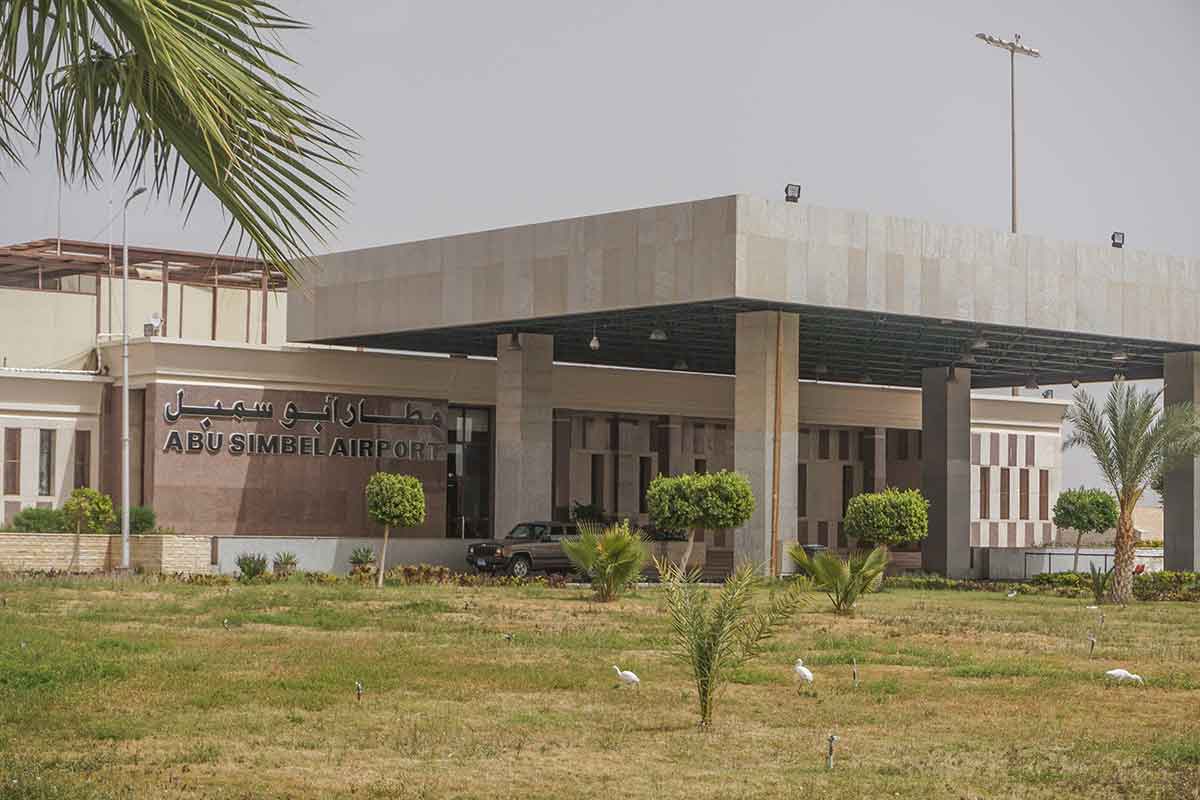Leaving Egypt without visiting Abu Simbel would be a great loss, especially for those on a Nile cruise. Despite being located at the southernmost point of the country, these monuments are easily accessible from Aswan, where most river tours end.
Abu Simbel is one of the most breathtaking architectural wonders of ancient Egypt, and missing out on it would be a shame. Therefore, thousands of visitors come here daily to experience this magnificent attraction firsthand. In this article, we will provide you with all the information you need to plan your visit to Abu Simbel. Keep in mind that Egipto Exclusivo can also arrange a customized trip to this awe-inspiring place.
Abu Simbel is situated at the southernmost point of Egypt, on the western shore of Lake Nasser, just a few kilometers from the border with Sudan. As there are no significant cities nearby, visiting Abu Simbel requires specific planning, as it is not on the way to any other tourist destination.
If you plan to visit Abu Simbel, you should take into account the following distances from other cities:
Regarding the weather, Abu Simbel has a pure desert climate. During the summer months, temperatures can easily exceed 40°C, while in winter, the highs do not drop below 23°C. However, when the sun sets, the minimum temperatures experience a significant drop. While there are no frost or freezing temperatures, the temperature variation can sometimes exceed 15°C between day and night. In summer, the minimum temperatures hover around 25°C, while in winter, they are around 10°C. Precipitation remains the same throughout the year: 0 mm.
Therefore, when visiting Abu Simbel, it is advisable to take extra precautions against the main risks of this climate: dehydration, sunstroke, and solar radiation, which can affect the eyes. Always have drinkable water on hand, use high-factor sunscreen, cover your head, and wear sunglasses.

As you prepare to visit Abu Simbel, it’s important to understand the history behind this magnificent construction. Abu Simbel is forever linked to Ramses II, one of the most powerful and famous pharaohs of ancient Egypt. He built this monument during the height of the New Kingdom and the Ramesside dynasty (19th Dynasty), dedicating it to several deities including Ra-Horakhti, Amun, and Ptah. But the true reason for its construction was to demonstrate his power over the southern enemies: the Nubians. It should be remembered that pharaohs were revered as gods, and visiting Abu Simbel is the best way to realize this.
Abu Simbel served as a warning to the Nubians and marked the border between their kingdom and that of the ancient Egyptians. Its most prominent features are the colossal sculptures of Ramses II and his favorite wife, Nefertari.
Construction began in the early years of his reign and lasted for about two decades due to the size of the undertaking. The motivation for the project was the Battle of Qadesh in 1274 BC, one of the most significant of that time fought in Canaan, which Ramses II claimed victory in.
However, the battle was more of a draw, and what was truly significant was the peace treaty that was signed between Ramses II and the Hittite king Hattusili III, making it the first documented peace treaty in history. Visiting Abu Simbel is an excellent way to experience the power and magnificence of ancient Egypt and appreciate its rich history.
Aside from its construction, two other significant moments in Abu Simbel’s history are the rediscovery and relocation of the temples. As the centuries passed, the maintenance of the temples became less important, and eventually, they were forgotten and buried under the desert sand, not even mentioned by the Greeks or Romans. The inexorable passage of time, in the form of desert sand, began to bury these constructions until they were practically forgotten after centuries.
In 1813, Swiss explorer Lewis Burkhardt stumbled upon Abu Simbel by chance, during the 19th century’s Egyptomania. He discovered large heads and headdresses protruding from the ground, leading to the excavation of the monument. Initially, the excavation lacked resources, and it was only possible to open an entrance, thanks to Italian Giovanni Belzoni’s efforts in the service of the British consul.
During this first inspection, the interior of the temples was found to be empty of the treasures of the past. Throughout the 19th century, a meticulous excavation process continued, with the difficult task of unearthing Abu Simbel in its entirety. It was finally concluded in 1909.
However, only a lucky few had the chance to visit Abu Simbel in its original location on the banks of the Nile River, and even they could only do so for a limited time. In the 1950s, the construction of the Aswan Dam posed the greatest threat to the integrity of these monuments. The dam, which was to be built a few kilometers downstream from the Nile River, would cause the river to rise, forming Lake Nasser and submerging the temples completely.
Fortunately, an international campaign was launched to save the temples from this fate. Sponsored and coordinated by UNESCO, the project involved the mammoth task of building two artificial mountains at a higher altitude, dividing the original monuments into large stone blocks, and reassembling them in their new location. It was one of the most significant heritage conservation projects ever undertaken and involved numerous teams of archaeologists and engineers from different countries. As a gesture of gratitude to the respective governments, Egypt gifted some of the temples in the area, which were also dismantled, numbered, and relocated to other countries. You can add the following temples to your list of future travels or evoke them when visiting Abu Simbel:
Whether you choose to visit Abu Simbel on your own or with a professional guide, it’s important to plan your excursion in advance due to the remote location of the site. To make the most of your visit, it’s helpful to know what elements make up these monuments and what spaces are included in the tours. Abu Simbel consists of two large speos (temples carved into rock) that are arranged side by side, each with its own unique features and historical significance.

The Great Temple of Abu Simbel, also known as the Temple of Ramses II, is the larger of the two temples and is dedicated to the gods Ra-Horakhti, Amun, and Ptah, who were among the supreme deities of ancient Egyptian religion. However, the temple also serves as a tribute to the pharaoh Ramses II, who is divinized both on the exterior and interior of the temple.
The exterior of the temple features four colossal seated statues of Ramses II, each standing at around 21 meters in height, making them the largest statues to have been preserved from ancient Egypt. Other members of his family, such as his mother Tiyi, his favorite wife Nefertari, and some of his children, are depicted at a smaller size but still larger than a human body, between his legs. Above the entrance is a large relief of Ra-Horakhti, the sun god with the head of a hawk.
The interior of the Great Temple of Abu Simbel has a simpler design compared to other Egyptian temples. Upon entering, visitors will find themselves in a large hypostyle hall, where Ramses II appears again, this time represented as Osiris in 9-meter statues attached to pillars. Behind this hall, there is a smaller room where his wife Nefertari appears in sacred boats along with other deities. The inner sanctuary, the final stop for visitors, features seated statues of Ptah, Amun, Ra-Horakhti, and Ramses II.
The simplicity of the interior design may have been intentional, as it creates a magical effect: a solar phenomenon that gives the temple greater symbolism. The temple’s precise orientation allows the sun’s rays to penetrate the interior chamber and illuminate three of the seated statues, excluding Ptah, who is often associated with the underworld and darkness. Witnessing this phenomenon in person during a visit to Abu Simbel is challenging since it only occurs two days a year, originally, on February 21st and October 21st. These dates may correspond to Ramses II’s coronation and birth, respectively, and may also be equidistant from the winter solstice, which is 61 days before and after. However, the shifting of the Tropic of Cancer over the millennia and the relocation of the temple may have affected the precision of this phenomenon, causing it to occur one day later.

Located adjacent to the Temple of Ramses II, the Temple of Hathor or Nefertari is a must-visit attraction in Abu Simbel. Dedicated to the goddess Hathor, who was closely associated with the queens of ancient Egypt, the temple is named after Queen Nefertari, who served as the inspiration for the monument. As Ramses II’s favorite wife, the Temple of Hathor is considered one of the expressions of his love and respect.
Upon entering, visitors are greeted with an impressive sight – Nefertari appears at the same height as Ramses II, standing tall at 10 meters. There are six colossal statues, four representing the pharaoh and two the queen.
Inside, the temple is even simpler than the Temple of Ramses II. Nefertari is depicted numerous times at the same height as Ramses II, accompanied by Hathor and other female deities such as Nut. The temple has a hypostyle hall with columns whose capitals take the form of Hathor with cow’s ears. It also features its own sanctuary and complementary rooms like small warehouses.
While most visitors choose to tour Abu Simbel during the day, it is also possible to visit the temples at night, which is highly recommended for a magical experience. During the night show, both temples are illuminated with special lighting, creating a fantastic display of light and color. Visitors can stay in one of the small hotels in the town of Abu Simbel or take a private cruise on Lake Nasser to experience the night tour.

Getting to Abu Simbel is relatively easy despite its remote location. The main way to reach the temple complex is by plane, as there is an airport in the town specifically built to receive flights from other cities in Egypt. This allows thousands of tourists to visit the site each year.
The airport in Abu Simbel is small and regional, with all flights being domestic. Here are some of the available air routes that you can take note of if you plan to visit Abu Simbel as part of your trip to Egypt:
An option is to arrive by boat through Lake Nasser, which is ideal for travelers doing a wider tour of the country. This must be done in a private cruise, as there is no regular service between its small port and Aswan. One of the great attractions of this means of transport is the ability to contemplate these temples and others located on the shores of this reservoir from a unique point of view. Since this mode of transport takes longer, visitors are ‘forced’ to stay in Abu Simbel overnight, which is also a spectacle worth seeing, as previously mentioned.
It’s important to note that it’s not possible to reach Abu Simbel directly by boat from the border city of Wadi Haifa in Sudan. The boats that leave from its port do not stop here and go directly to Aswan.
Another way to get to Abu Simbel is by road transport. Although the road is in good condition, the journey takes longer than by plane. However, it’s a common option for groups of tourists traveling by bus. Here are some indicative durations:
It’s worth noting that, for some travelers, making this journey by road has a peculiar attraction: trying to spot a mirage. The Western Desert of Egypt, and particularly this stretch between Aswan and Abu Simbel, is conducive to the formation of this optical illusion, originated by the layers of hot air that make the observer believe that there is a water surface in the distance, like an oasis.
Finally, if you want a private vehicle with a driver to visit Abu Simbel from any city, Egipto Exclusivo provides a tailor-made service at the time you want, with comfortable vehicles equipped with air conditioning, among other amenities.


Fill out the form below to receive a free, no-obligation, tailor-made quote from an agency specialized in Egypt.
Travel agency and DMC specializing in private and tailor-made trips to Egypt.
Mandala Tours, S.L, NIF: B51037471
License: C.I.AN-187782-3